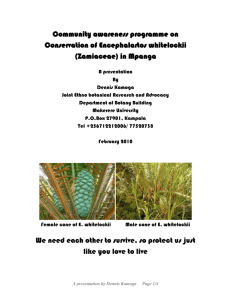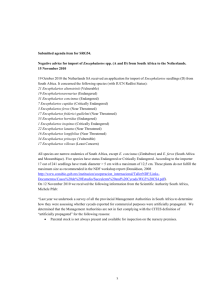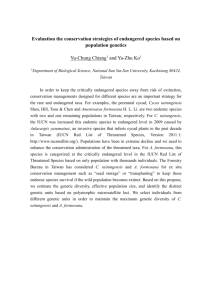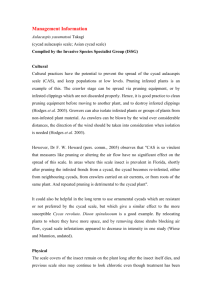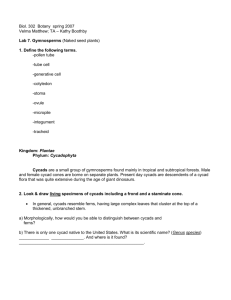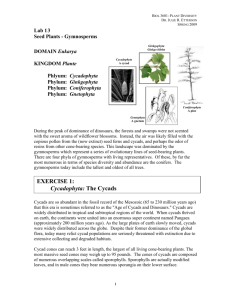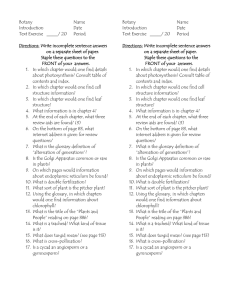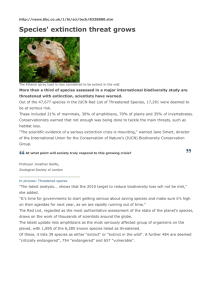List of Threatened Species™ The IUCN Red October 2010 update
advertisement
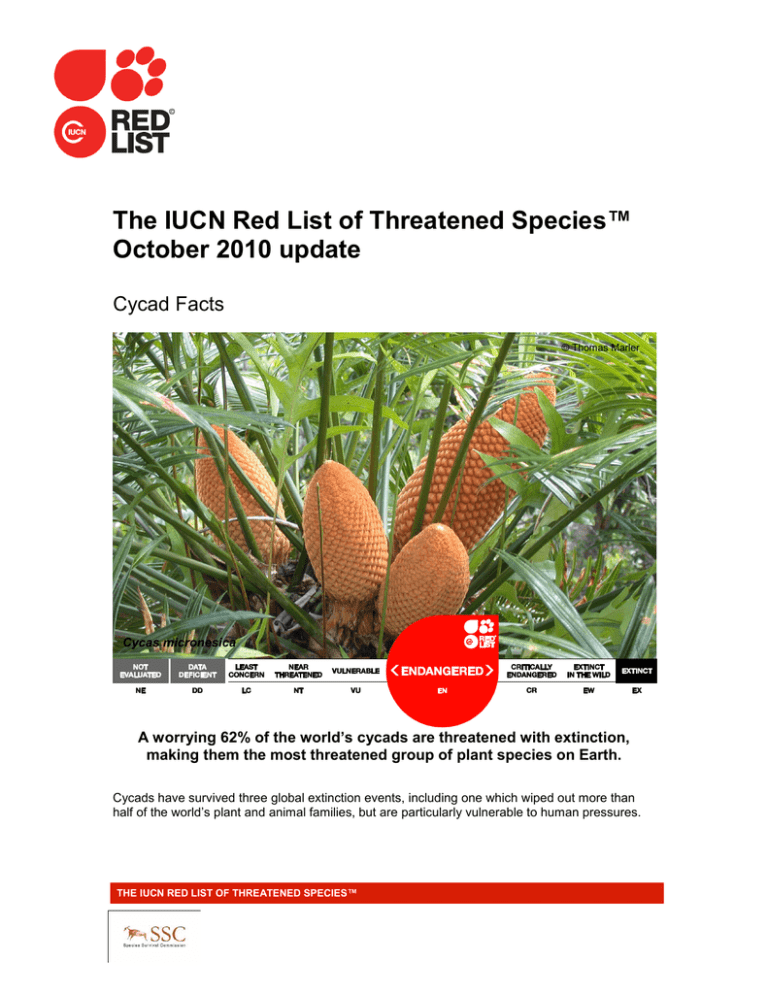
The IUCN Red List of Threatened Species™ October 2010 update Cycad Facts © Thomas Marler Cycas micronesica A worrying 62% of the world’s cycads are threatened with extinction, making them the most threatened group of plant species on Earth. Cycads have survived three global extinction events, including one which wiped out more than half of the world’s plant and animal families, but are particularly vulnerable to human pressures. THE IUCN RED LIST OF THREATENED SPECIES™ Wyoming Toad Why worry about cycads? Cycads are the oldest living seed plants, originating approximately 300 million years ago. They existed throughout the time of the dinosaurs, forming 20% of the world’s flora during the Jurassic period when species such as the Diplodocus and Stegosaurus roamed the Earth. As such, cycads are sometimes referred to as ‘living fossils’, providing us with a window to the past. Cycads are widely used by people all over the world. In Africa, they are used as famine food, but in parts of Asia and South and Central America, they form a regular part of people’s diets. The leaves of cycads are also frequently harvested for cultural events and for floral arrangements. They act as hosts for numerous other organisms, especially beetles. In all areas where cycads are found, they have specific organisms that occur with them, and they often have specialized interactions with beetles that are linked to pollination. Cycads also have unique characteristics, including various chemicals that are not found in any other plant groups. Cycads at risk… Following the last global assessment of cycads in 2003, it was found that 53% of this group were threatened with extinction. Now, seven years on, it is clear that the situation is quickly deteriorating, with a total of 62% of cycad species now threatened. Of particular concern is that this plant group is in decline all over the world, with Asia, Australia, and South and Central America all demonstrating a major shift towards a higher proportion of threatened cycad species. Since 2003, two cycad species have become Extinct in the Wild. Both of these were from South Africa, where illegal removal from the wild for private collections is an ongoing problem. Unfortunately, cycad species can be very slowgrowing, with some estimated to have a generation time of more than 500 years. This means that populations take a very long time to recover if adult plants are removed, for instance for private collections. A total of thirty-nine cycad species are found at just one site; as a result, any chance events at these sites, such as wild fire, disease outbreaks or introduction of an invasive species, could have a dramatic effect on the species, and cause a rapid change in conservation status. Two examples of threatened cycad species are Encephalartos whitelockii and Cycas micronesica. Dieback of a female Cycas micronesica cycad on the island of Guam. The plant has been infested by tiny white Asian cycad scale insects. © Thomas Marler The IUCN Red List of Threatened Species™ Encephalartos whitelockii – CR This spectacular cycad is endemic to the Mpanga Gorge in Uganda, where it forms one of the most impressive cycad populations in Africa. The greatest threat to this species is the ongoing construction of a hydro-electric power station above the Mpanga Falls, with the development of this new power station resulting in the elevation of this cycad’s IUCN Red List status. The activities of local communities pose an additional threat, with seasonal fires and deliberate felling being particularly problematic. Owing to the increased pressure on the E. whitelockii population, mitigation measures for the site include a local community-based conservation project, which aims to raise community awareness of the conservation and importance of the species, as well as a seed bank and nursery. The propagation of E. whitelockii in a nursery will provide individuals for replanting in the wild. Photo: © Michael McLeish Cycas micronesica - EN This species occurs in remnant native forest on the islands of Guam, Rota, Yap and Palau in the western Pacific Ocean. The major historical threat was habitat destruction, but despite loss of habitat this species was the most abundant tree on Guam at the th end of the 20 century. However, the scale Aulacaspis yasumatsui invaded Guam in 2003, and the butterfly Chilades pandava followed in 2005. These cycad-specific pests have combined with other herbivores to eliminate seedling and juvenile trees and reduce the population of mature trees by 75%. There is no recruitment due to reduced seed production and low germination combined with scale infestations that kill all new seedlings. The scale pest has spread throughout all cycad-inhabited forests of Guam and onto the islands of Rota and Palau. In case this species becomes locally extinct on Guam and Rota, three ex-situ cycad gardens have been established with seeds from several different habitats around Guam. Photo: © Thomas Marler The IUCN Red List of Threatened Species™
